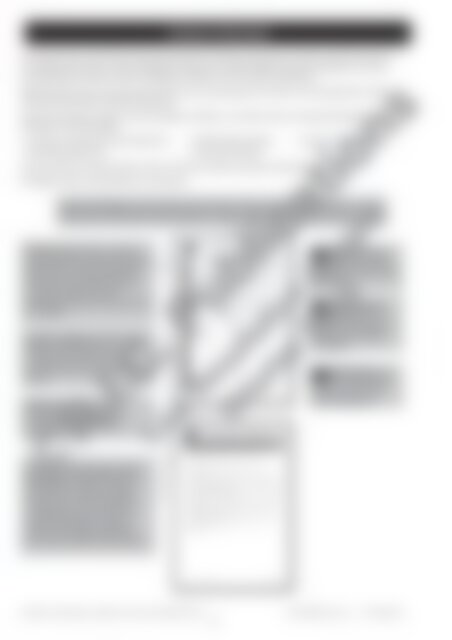20884 ACE Language (Yr 3) Paragraphs
Create successful ePaper yourself
Turn your PDF publications into a flip-book with our unique Google optimized e-Paper software.
Format of the book<br />
This teacher resource book includes supporting materials for teaching and learning in the sub-strand of Text structure<br />
and organisation within the strand of <strong>Language</strong> in Australian Curriculum English. All content descriptions in the substrand<br />
have been included, as well as teaching points based on the Curriculum’s elaborations.<br />
While the book focuses on the sub-strand of Text structure and organisation, activities and interrelated links to other<br />
strands and sub-strands have been incorporated.<br />
Each section supports a specific content description and follows a consistent format, containing the following<br />
information over several pages:<br />
• activities to develop the content descriptions • student blackline masters • resource sheets<br />
• interrelated English links<br />
• assessment checklist<br />
Answers relating to student blackline masters have been included at the back of the book.<br />
The length of each content description section varies.<br />
Teacher information includes background information relating to the content description, as well as<br />
related terms and desirable student vocabulary and other useful details which may assist the teacher.<br />
Related terms includes vocabulary<br />
associated with the content description.<br />
Many of these relate to the glossary<br />
in the back of the official Australian<br />
Curriculum English document;<br />
additional related terms may also have<br />
been added.<br />
Student vocabulary includes words<br />
which the teacher would use—<br />
and expect the students to learn,<br />
understand and use—during English<br />
lessons.<br />
Further resources by R.I.C.<br />
Publications or other publishers<br />
or authors are included where<br />
appropriate.<br />
Understand how different types of texts vary in use of language choices, depending on their<br />
purpose and context (for example, tense and types of sentences) (<strong>ACE</strong>LA1478)<br />
© Australian Curriculum: Assessment and Reporting Authority 2012<br />
Related terms<br />
Teacher information<br />
Texts<br />
What this means<br />
?<br />
<br />
<br />
.<br />
.g.<br />
<br />
Text structure<br />
<br />
T<br />
<br />
.g.<br />
<br />
s,s,s,<br />
e,s,<br />
.<br />
,s,s,.<br />
<strong>Language</strong> features<br />
Teaching points<br />
F, T<br />
e,<br />
.<br />
<br />
<br />
.<br />
student’s.<br />
<br />
Imaginative texts<br />
<br />
T<br />
’s.<br />
T<br />
<br />
,s,s,<br />
<br />
e.<br />
Informative texts<br />
T<br />
Elaboration<br />
E<br />
e,<br />
E1.<br />
.<br />
Persuasive texts<br />
T<br />
<br />
Further resources<br />
T<br />
e.<br />
Primar.<br />
.<br />
<br />
Student vocabulary<br />
.<br />
<br />
<br />
<br />
<br />
<br />
<br />
<br />
.<br />
<br />
<br />
<br />
<br />
<br />
<br />
<br />
<br />
<br />
fi<br />
<br />
<br />
<br />
<br />
<br />
<br />
<br />
<br />
y<br />
<br />
<br />
<br />
<br />
<br />
Australian Curriculum English www.ricpublications.com.au R.I.C. Publications ®<br />
2<br />
Text structure<br />
and organisation<br />
Text structure<br />
and organisation<br />
Understand how different types of texts vary in use of language Activities to<br />
choices, depending on their purpose and context (fro example, tense<br />
and types of sentences) (<strong>ACE</strong>LA1478)<br />
develop the<br />
© Australian Curriculum: Assessment and Reporting Authority 2012 content description<br />
? What this means<br />
provides a general<br />
explanation of the content<br />
description.<br />
T Teaching points<br />
provides a list of<br />
the main teaching points<br />
relating to the content<br />
description.<br />
E Elaborations are a<br />
list of elaborations<br />
based on those in the<br />
content description.<br />
E1 Identifies and analyses the text structures and language features of different text types<br />
Activities to develop the content<br />
description includes descriptions or<br />
instructions for activities or games<br />
relating to the content descriptions<br />
or elaborations. Some activities are<br />
supported by blackline masters or<br />
resource sheets. Where applicable,<br />
these will be stated for easy reference.<br />
Analysing text structures and language features of various text types (pages 12 to 25)<br />
Pages 4 to 10 provide teacher information, student activities and examples of seven imaginative, informative and persuasive text types written in the<br />
forms of a narrative, a recount, a procedure, a report, a review, an explanation and an exposition. These pages support the blackline masters provided on<br />
pages 12 to 25.<br />
Each text type in pages 4 to 10 includes:<br />
– information for the teacher about the various language and structural features, and the purpose of the specifi c text type<br />
– a detailed analysis of the structural and language features of the text presented in the sample texts provided on pages 12 to 25<br />
– suggested activities for helping students analyse structural and language features, and the purpose of the specifi c text type<br />
– answers for the student analysis worksheets are provided at the back of the book.<br />
Looking at texts (page 11)<br />
Provide students with a range of texts from short stories and novels, appropriate articles or reports from magazines and newspapers, recipes,<br />
experiments, nonfi ction material, unseen texts written by other students or the teacher and online texts. Ensure there is a range of different text types.<br />
Students answer the questions on the blackline on page 11 about their chosen text. This activity will help them to identify structures and language<br />
features in different texts and compare the similarities and differences as they scan the text to answer the questions. It will also help them to identify the<br />
purpose for which a text was written and consider the text type they choose to write according to its purpose. Note: This activity is best completed after<br />
practice in analysing a range of text types such as those on pages 12 to 25.<br />
<strong>Language</strong> and text structure revision/introduction activities<br />
As students need to identify language features such as verb tense, use of adverbs and adjectives to enhance and /or clarify meaning, paragraphing and<br />
use of text connectives such as conjunctions, they will need revision/teaching to become familiar with these. The Primary grammar and word study series<br />
by R.I.C. Publications provides background information for the teacher, teaching suggestions and teacher student worksheets on these aspects. The<br />
content description on pages 28 to 41 of this book also treats paragraphing in detail.<br />
Text type ‘jigsaws’<br />
To help students identify the structure of different text types, enlarge the sample texts on pages 12, 14, 16, 18, 20, 22 and 24. Cut them into sections;<br />
e.g. cut the narrative on page 12, ‘How the moon got into the sky’, by title, orientation, complication, events, resolution and ending. Write these<br />
headings on separate strips of card. Place the ‘jigsaw’ pieces of the narrative in a plastic sleeve labelled ‘Narrative’, along with the heading cards.<br />
Students can take out the pieces, lay the story in order and place each heading card next to the correct part of the narrative.<br />
Identifying language features in text types<br />
To help students identify the language features of text types, enlarge the sample texts on pages 12, 14, 16, 18, 20, 22, and 24. As a class or in small<br />
groups, assist students to identify verbs, adverbs, adjectives, paragraphs, text connectives and so on by colour coding the language features. The text can<br />
also be scanned, or copied and pasted into an interactive whiteboard program.<br />
Venn diagram<br />
Construct a Venn diagram comparing the structure and language features of two text types such as a narrative and a recount.<br />
Interrelated English links: See page 27.<br />
R.I.C. Publications® www.ricpublications.com.au Australian Curriculum English<br />
3<br />
Australian Curriculum English – <strong>Language</strong>: Text structure and organisation (Year 3) www.ricpublications.com.au R.I.C. Publications ®<br />
iv


















